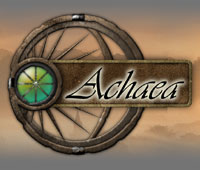A MUD is a multiplayer real-time virtual world, usually text-based or storyboarded. MUDs combine elements of role-playing games, hack and slash, player versus player, interactive fiction, and online chat. Players can read or view descriptions of rooms, objects, other players, and non-player characters, and perform actions in the virtual world that are typically also described. Players typically interact with each other and the world by typing commands that resemble a natural language, as well as using a character typically called an avatar.
In multiplayer online games, a MUSH is a text-based online social medium to which multiple users are connected at the same time. MUSHes are often used for online social intercourse and role-playing games, although the first forms of MUSH do not appear to be coded specifically to implement gaming activity. MUSH software was originally derived from MUDs; today's two major MUSH variants are descended from TinyMUD, which was fundamentally a social game. MUSH has forked over the years and there are now different varieties with different features, although most have strong similarities and one who is fluent in coding one variety can switch to coding for the other with only a little effort. The source code for most widely used MUSH servers is open source and available from its current maintainers.
AberMUD was the first popular open source MUD. It was named after the town Aberystwyth, in which it was written. The first version was written in B by Alan Cox, Richard Acott, Jim Finnis, and Leon Thrane based at University of Wales, Aberystwyth for an old Honeywell mainframe and opened in 1987.

Simutronics is an American online games company whose products include GemStone IV and DragonRealms. It was founded in 1987 by David Whatley, with husband and wife Tom & Susan Zelinski. The company is located in St. Louis, Missouri. It became part of the Stillfront Group in 2016.

GEnie was an online service created by a General Electric business, GEIS, that ran from 1985 through the end of 1999. In 1994, GEnie claimed around 350,000 users. Peak simultaneous usage was around 10,000 users. It was one of the pioneering services in the field, though eventually replaced by the World Wide Web and graphics-based services, most notably AOL.
DikuMUD is a multiplayer text-based role-playing game, which is a type of multi-user domain (MUD). It was written in 1990 and 1991 by Sebastian Hammer, Tom Madsen, Katja Nyboe, Michael Seifert, and Hans Henrik Stærfeldt at DIKU —the department of computer science at the University of Copenhagen in Copenhagen, Denmark.

Ancient Anguish, abbreviated AA, is a fantasy-themed MUD, a text-based online role-playing game. Founded in 1991 by Balz "Zor" Meierhans and Olivier "Drake" Maquelin, it opened to the public on February 2, 1992. It is free-to-play, but has been supported by player donations since 1994.
Player versus player (PvP) is a type of multiplayer interactive conflict within a game between human players. This is often compared to player versus environment (PvE), in which the game itself controls its players' opponents. The terms are most often used in games where both activities exist, particularly MMORPGs, MUDs, and other role-playing video games, to distinguish between gamemodes. PvP can be broadly used to describe any game, or aspect of a game, where players compete against each other. PvP is often controversial when used in role-playing games. In most cases, there are vast differences in abilities between players. PvP can even encourage experienced players to immediately attack and kill inexperienced players. PvP is often referred to as player killing in the cases of games which contain, but do not focus on, such interaction.
LPMud, abbreviated LP, is a family of MUD server software. Its first instance, the original LPMud game driver, was developed in 1989 by Lars Pensjö. LPMud was innovative in its separation of the MUD infrastructure into a virtual machine and a development framework written in the LPC programming language.
A persistent world or persistent state world (PSW) is a virtual world which, by the definition by Richard Bartle, "continues to exist and develop internally even when there are no people interacting with it". The first virtual worlds were text-based and often called MUDs, but the term is frequently used in relation to massively multiplayer online role-playing games (MMORPGs) and pervasive games. Examples of persistent worlds that exist in video games include Battle Dawn, EVE Online, and Realms of Trinity.

The Realm Online, originally known as The Realm, is a massively multiplayer online role playing game (MMORPG) launched in December 1996 for Windows PC. It was designed in the tradition of graphical MUDs, before the usage of the terms "massively multiplayer" and "MMORPG".
Player versus environment is a term used for both single player and online games, particularly MMORPGs, CORPGs, MUDs, other online role-playing video games and survival games to refer to fighting computer-controlled enemies—in contrast to PvP. In survival games a large part may be fighting the elements, controlling hunger and thirst, learning to adapt to the environment and exploration.
A mob, short for mobile or mobile object, is a computer-controlled non-player character (NPC) in a video game such as an MMORPG or MUD. Depending on context, every and any such character in a game may be considered to be a "mob", or usage of the term may be limited to hostile NPCs and/or NPCs vulnerable to attack.
Federation II was a free-to-play online text-based game also known as Federation 2 or Fed2. It was designed by British programmer Alan Lenton and developed by IBGames. It centers on the intergalactic trade and economy in the distant future. It is coded in C++
A MOO is a text-based online virtual reality system to which multiple users (players) are connected at the same time.
Dragon's Gate was an interactive, real time, text-based multi user online fantasy role-playing game, sometimes referred to as a MUD. It was one of the longest running pay-for-play online games in the world, it opened to the public in the spring of 1990 on GEnie. In 1996 the game was moved to AOL. Later the game was moved to Mythic Realms, and finally to independent server, where it ran until the summer of 2007.

Achaea, Dreams of Divine Lands is a roleplay-focused, text-based multi-user dungeon (MUD) released on September 9, 1997. It was published by Achaea LLC, now known as Iron Realms Entertainment. Achaea is operated by collecting the revenue through a microtransaction system, which allows payment for the acquisition of in-game benefits.
TinyMUCK or, more broadly, a MUCK, is a type of user-extendable online text-based role-playing game, designed for role playing and social interaction. Backronyms like "Multi-User Chat/Created/Computer/Character/Carnal Kingdom" and "Multi-User Construction Kit" are sometimes cited, but are not the actual origin of the term; "muck" is simply a play on the term MUD.

LegendMUD is a text-only MUD game founded by a group of friends including virtual world designer Raph Koster. It features historically significant story elements and award-winning gameplay. It opened publicly on February 14, 1994. It has received critical praise for its research and attention to detail in reconstructing past cultures within the game context.
David Whatley is the president and CEO of Simutronics Corporation, a multiplayer game company in St. Charles, Missouri. He was the co-founder of the company in 1987, and has been a key developer on all of the company's products, including the GemStone series, DragonRealms, Modus Operandi, Alliance of Heroes, and CyberStrike, which won the Online Game of the Year award from Computer Gaming World magazine in 1993.







